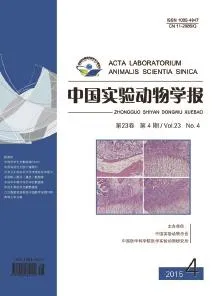动物学
2015-02-27
动物学

不同浓度葡聚糖硫酸钠对小鼠炎症性肠病模型建立及其致病相关免疫因子表达的影响
李欣,武文卿,张卓超,等
目的:探讨饮用不同浓度的葡聚糖硫酸钠(dextran sulfate sodium,DSS)对于建立小鼠炎症性肠病(inflammatory bowel disease,IBD)模型及其致病相关免疫因子表达的影响。方法:雄性C57BL/6J小鼠随机分为对照组和不同浓度的DSS饮用组(3%、5%、7%)。观察小鼠的大便性状,体重和生存时间。饮用后的第6天处死各组小鼠,观察结肠大体形态并评分;取病变处进行石蜡包埋病理切片,苏木素伊红染色并进行病理组织学评分;定量PCR检测各组脾细胞免疫因子表达情况。结果:饮用3%、5%、7%浓度DSS的小鼠在第6天均有不同程度溃疡形成,成模率随着DSS浓度提升而增加,但是小鼠死亡率也相应增加。定量PCR结果表明促炎因子(TNF-α、IFN-γ和IL-17A)的表达水平与DSS浓度成正相关,而抑炎因子(IL-4和IL-10)以及调节性T细胞相关的转录因子Foxp3的表达水平与DSS浓度成负相关关系。结论:给予小鼠5%浓度的DSS溶液饮用有助于高效经济地建立小鼠IBD模型,为进一步研究IBD的发病机理、生物学特性、干预因素等打下了重要基础。
葡聚糖硫酸钠;炎症性肠病;小鼠模型
来源出版物:中国实验动物学报, 2015, 23(4): 336-341联系邮箱:宁守斌,ning-shoubin@163.com

来源出版物:Current Zoology, 2015, 61(4): 569-577联系邮箱:Jacopo P. MORTOLA, jacopo.mortola@mcgill.ca
封面介绍:Many aquatic and semi-aquatic mammals of medium and large size when resting ashore or at the water surface breathe with a low frequencyfby comparison to terrestrial mammals of the same body size. From a gathering of literature data, it appears that such difference does not apply to heart rate (HR). Therefore, their HR-f ratio can be much higher than in terrestrial mammals of similar body mass. The results agree with the possibility that the low frequency of aquatic and semi-aquatic mammals may have evolved for a non-respiratory function, namely the regulation of buoyancy at the water surface.
The heart rate-breathing rate relationship in aquatic mammals: A comparative analysis with terrestrial species
Jacopo P. MORTOLA
Aquatic and semi-aquatic mammals, while resting at the water surface or ashore, breathe with a low frequency (f) by comparison to terrestrial mammals of the same body size, the difference increasing the larger the species. Among various interpretations, it was suggested that the low-fbreathing is a consequence of the end-inspiratory breath-holding pattern adopted by aquatic mammals to favour buoyancy at the water surface, and evolved to be part of the genetic makeup. If this interpretation was correct it could be expected that, differently fromf, the heart rate (HR, beats/min) of aquatic and semi-aquatic mammals at rest would not need to differ from that of terrestrial mammals and that their HR-fratio would be higher than in terrestrial species. Literature data for HR (beats/min) in mammals at rest were gathered for 56 terrestrial and 27 aquatic species. In aquatic mammals the allometric curve (HR=191·M-0.18;M= body mass, kg) did not differ from that of terrestrial species (HR=212·M-0.22) and their HR-fratio (on average 32±5) was much higher than in terrestrial species (5±1) (P<0.0001). The comparison of these HR allometric curves to those forfpreviously published indicated that the HR-fratio was body size-independent in terrestrial species while it increased significantly with M in aquatic species. The similarity in HR and differences infbetween aquatic and terrestrial mammals agree with the possibility that the lowfof aquatic and semi-aquatic mammals may have evolved for a non-respiratory function, namely the regulation of buoyancy at the water surface .
allometry; breathing pattern; control of breathing; diving;cardio-respiratory coupling
